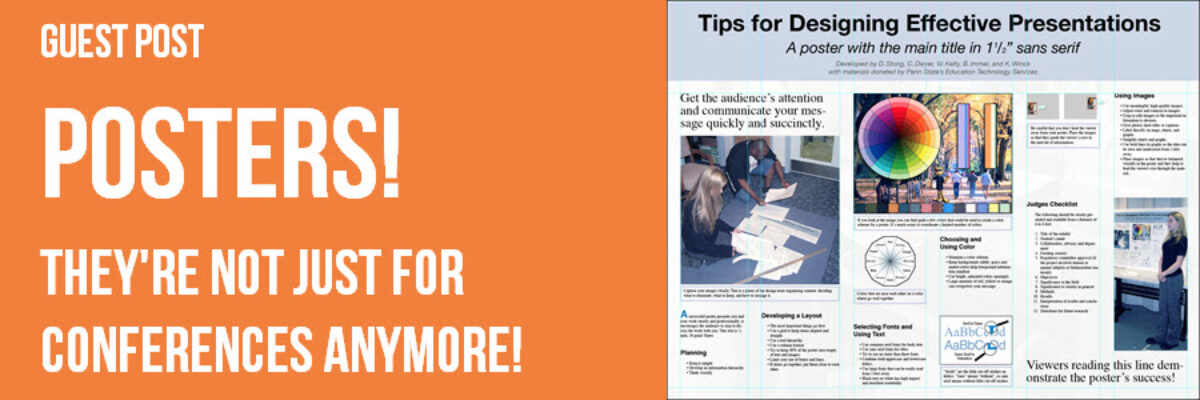SE Note: I almost never make posters but I know they are a hot reporting tool for many of you, so I asked poster veteran Kylie Hutchinson to share her secrets.
Posters are an important, but often overlooked, dissemination tool for visually communicating your results. Traditionally, we think of posters as an academic thing, but they’re not just for conferences anymore! An effectively designed poster can be very “sticky” compared to other forms of reporting. While a fifty-page report is sitting on a shelf somewhere collecting dust, a poster can hang around an organization’s lunch room or hallway for a long time, continuing to engage stakeholders and disseminate your key messages.
The first time I participated in a conference poster session was a disaster. I had completed an evaluation for an HIV organization and someone on staff wanted to present the results at a health care conference. They found a graphic designer to prepare a poster and when I saw it I thought, “Wow, that’s pretty”. I decided to submit it myself to the American Evaluation Association conference that same year. At the appointed time, I proudly tacked my poster to the wall and proceeded to stand there for the next two hours like an awkward wallflower at a teen dance. Nobody stopped to look at it, and no one talked to me. I felt like a real loser.

Kylie’s first disastrous experience with a conference poster. How would you improve upon this example? Add your ideas to the comments below.
It was a disappointing experience, but the following year I was (ironically) asked to be a poster judge for the same conference. I quickly learned what I wished I’d known the year before. Here are a few quick tips I’ve summarized from other sources on how to rock your poster presentation and reach the widest audience possible.
Design
- Organize your content into sections with clear headings that help orient the reader quickly. Consider using questions as headers instead of the traditional Introduction, Methods, Results, etc.
- Readers tend to read from top to bottom, so use a column format to vertically structure the flow of your sections. After the title (top and centered), the most important area for reader attention is the top left corner.
- Keep the design neat and clutter free. Avoid lengthy text paragraphs and aim for 40% white space. Avoid placing borders around text boxes and images which can interrupt the flow.
- Opt for dark colored letters on a neutral or light background for better readability. Avoid bright colored backgrounds.
- Limit your use of colors to two or three. If possible, choose colors that are related to your subject area.
- Use a font size that is large enough to read from 5-6 feet away. Use a sans serif font for headings and a serif font for body text.
- Capitalize Each Word of your title instead of ALL CAPS for better readability.
- Do a mock up by printing out each section separately, then lay them out on the floor or kitchen table. Move them around to play with different formats.
Images
- Use charts, illustrations, and images to break up large sections of text.
- Pick relevant and meaningful images that will help to quickly communicate your subject matter. Your own photos are preferable to stock photos, provided they are high quality.
- Crop images to include only the most important content.
- Choose simple and bold illustrations rather than finely detailed ones. And because you’re reading Stephanie’s blog, I don’t need to tell you how to format your charts!
Content
- Tell a story about your work and why it matters as succinctly as possible: what you did, what you learned, and what you recommend going forward. The poster should be self-explanatory to someone reading it on their own.
- Turn off your computer and think of three to five key messages that you wish to convey. Use these as the basis for your content.
- Ensure both the question you addressed and your conclusions are stated clearly.
- Avoid excessive details on the methods you used, unless that is the focus of your topic.
- Prepare a more detailed one or two-page summary handout as a take-away. Include your contact information.
Here’s a better example of a poster that’s also a tip sheet.

Strong, D. R. (2005). Designing communications for a poster fair. Pennsylvania State University. Retrieved from: http://www.personal.psu.edu/drs18/postershow/. Used with permission.
If you follow these tips you’ll be well on your way to being a poster rock star. But don’t forget to get it professionally printed! You don’t want to embarrass yourself by pasting together a series of 8 x 11 sheets on Bristol board. There are reliable companies that will print your poster online and ship it directly to your conference location so you don’t have to travel with that awkward tube.
If you’re curious to learn more about effective poster presentations, check out some of the resources below.
Kylie Hutchinson is principal consultant with Community Solutions Planning & Evaluation and the author of Survive and Thrive: Three Steps to Securing Your Program’s Sustainability. She is currently writing two books; one on effective evaluation reporting and another on learning from evaluation failures.
Sources:
Strong, D. R. (2005). Designing communications for a poster fair. Pennsylvania State University. Retrieved from: http://www.personal.psu.edu/drs18/postershow/.
Evergreen, S. (n.d.) Potent presentations initiative: Guidelines for posters. American Evaluation Association. Retrieved from http://www.eval.org/page/p2i-tools.
Hess, G. & L. Liegel. (2008). Creating effective poster presentations. Retrieved from: https://projects.ncsu.edu/project/posters/documents/QuickReferenceV3.pdf.

